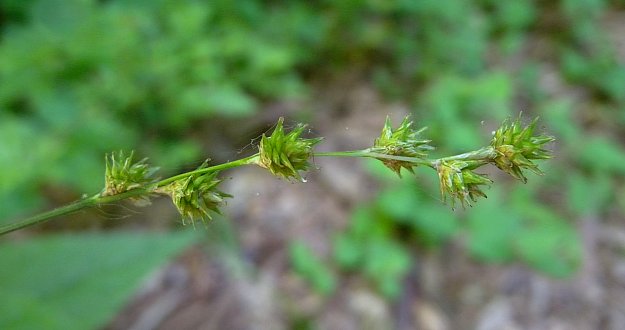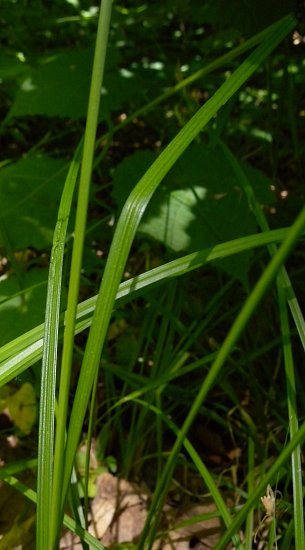
The spikelets are gynecandrous with staminate florets underneath the pistillate florets. Individual spikelets are 5-10 mm. long and either ovoid-globoid or globoid in form; they are prickly in appearance from the slender beaks of their spreading to ascending perigynia (sacs containing the pistillate florets). The uppermost spikelet of each inflorescence is strongly club-shaped at the bottom because of the abundance of its staminate florets, while the remaining spikelets are barely to moderately club-shaped. The perigynia are 3-4 mm. long, 1.5-2.0 mm. across, and plano-convex; they are ovate in shape, tapering to slender beaks at their apices. The margins of the perigynia are slightly winged throughout, while their bases are rounded. Usually there are several longitudinal veins along their outer surfaces, while their inner surfaces are veinless or only slightly veined. The pistillate scales are 2.0-3.5 mm. in length and lanceolate in shape; they are longitudinally veined along their centers and membranous along their margins. The blooming period occurs from late spring to early summer, lasting about 1-2 weeks. The florets are cross-pollinated by the wind. At maturity, the perigynia disarticulate; they are flat and light enough to be blown about by the wind. The root system is fibrous and short-rhizomatous.
Cultivation: The preference is full sun to moderate shade, moist to mesic conditions, and soil containing loam, clay-loam, or silt-loam. This adaptable sedge has a rather floppy habit. Most growth and development occur during the spring and early summer.

Range & Habitat: The native Remote Sedge (Carex tenera) is occasional throughout Illinois (see Distribution Map). Habitats include open woodlands (both upland and lowland), disturbed woodlands, moist savannas, woodland edges and openings, areas along woodland paths, swamps, moist to mesic prairies, disturbed meadows, and ditches. This sedge has low fidelity to any particular habitat, occurring in both higher quality natural areas and disturbed areas. In some habitats, it is being displaced by European honeysuckle shrubs (Lonicera spp.) and Alliaria petiolata (Garlic Mustard).
Faunal Associations: Various parts of sedges (Carex spp.) in woodlands are eaten by many species of insects, birds, and other fauna. Examples include the caterpillars of two butterflies, Satyrodes appalachia (Appalachian Brown) and Satyrodes eurydice (Eyed Brown), which feed on the foliage. Other insect feeders include aphids (Thripsaphis spp. & others), leafhoppers (Cosmotettix spp. & others), seed bugs (Lygaeidae), plant bugs (Miridae), and stink bugs (Pentatomidae). Among vertebrate animals, some upland gamebirds and granivorous songbirds eat the seeds of these sedges. This includes the American Woodcock, Wild Turkey, Ruffed Grouse (young chicks), Eastern Towhee, Cardinal, and various sparrows. Tree squirrels, including the Fox Squirrel and Gray Squirrel, also eat the seeds. Sedges provide cover for some woodland songbirds that nest on the ground.
Photographic Location: Along a woodland path in Springfield, Illinois.
Comments: Remote Sedge (Carex tenera) can be distinguished from other Carex spp. in the difficult Ovales section by the wide spacing between its spikelets along the rachis of the inflorescence. Most sedges in this section have their spikelets spaced close together and overlapping each other. Remote Sedge can be distinguished from a similar species, Carex projecta (Necklace Sedge), by its more narrow leaves (1-3 mm. across); the latter has leaves 3-6 mm. across. In addition, Necklace Sedge tends to have more spikelets in its inflorescence (8-14) that are spaced even more widely apart. Two varieties of Remote Sedge have been described: the typical variety (described here) and var. echinodes. This latter variety is less common. It differs from the typical variety by having longer perigynia (typically 4.0-4.5 mm. in length) that are more widely spreading in the spikelets. The sheaths of this latter variety are supposed to be more smooth than those of the typical variety. Some authors, such as Mohlenbrock (1999/2011), regard Carex tenera echinodes as a distinct species, or Carex echinodes.